Activities
Comparing water access and challenges table
Use this table to compare water access issues between two countries. This is from the Global Perspectives Activity.
ViewActivities
Investigating the water cycle experiment
A table for students to design a model that allows them to investigate and observe at least 2 processes in the water cycle
ViewActivities
Land use - impacts on waterways
An interactive to discover the issues involving land use and water quality.
View
Links
Clean water and sanitation
Global goals for clean water and sanitation. Ensure availability and sustainable management of water and sanitation for all.
ViewLinks
Waikato Coastcare groups
A webpage of Waikato coastcare groups from Waikato Regional Council website
ViewResources
Water saving actions at school and outdoors
A poster of water saving actions at school and outdoors
View
Articles
What is climate change - SLH
Article and videos to understand climate and climate change. Science Learning Hub
View
Articles
Te mana o te wai - Water NZ - bilingual poster
“Te Mana o te Wai is a concept that refers to the fundamental importance of water and recognises that protecting the health of freshwater protects the health and well-being of the wider environment...." National Policy Statement for Freshwater Management 2020 (NPS-FM 2020). A Bilingual perspective to the six principles of Te Mana o te Wai.
ViewActivities
Smart Water inquiry
These resources use an inquiry approach to connect with water in the Waikato region.
View
Links
New Zealand Topographical map
Explore local waterways and water features on line with NZ Topographic maps,
ViewArticles
Beneath the surface - The state of India's water 2019
A pdf of the state of India's water 2019
View
Resources
Hamilton Water Sources and Supply Map
This map show water catchments, water treatment plants and reservoirs around Hamilton. Use this map for completing activities in 'Water in the Waikato' exercise.
View
Media
Water is Taonga - Slideshow
This slideshow is part of a larger inquiry unit about freshwater by Smart Water and the Science Learning Hub. It can be used for all inquiry activity topics in the Smart Water Schools resource. The slideshow gives prompts and discussion points to support your learning journey. Also links to videos about water.
View
Media
Turn dirty water into clean Water!
A video of an experiment to show how to turn dirty water into clean.
ViewArticles
Te Mana o te awa
An article about the spiritual authority, protective power and prestige of the river.
View
Media
Water is everywhere
Water appears to be plentiful and all around us in NZ. Oceans surround us. There are hundreds of lakes and rivers. Some South Island regions get more than 10 metres of rain each year. We have so much water, it’s easy to forget how important and unusual water really is. This short video explores states of water and places we find water. Courtesy of Science Learning Hub.
View
Links
Three Waters Viewer - Hamilton City
Find your local water reservoirs, main lines and storm water with this interactive map.
View
Links
Constructing an aquifer model
An activity for students to build an aquifer model and examine how water gets into the groundwater system.
ViewArticles
Understanding kaitiakitanga
An article to understand of the Maori perspectives relating to the world around us.
View
Resources
Sources of drinking water for Waipā district
This map show catchments, water sources, water treatment plants and reservoirs around Waipa. Use this map for completing activities in 'Water in the Waikato' exercise.
ViewResources
Water saving actions in the bathroom
A poster of water saving actions in the bathroom
ViewActivities
Comparing water access and challenges
A table to compare water access and challenges
ViewResources
Sources of drinking water of the Waipa district
An image resource of drinking water for the Waipa dIstrict
ViewActivities
Student handout - steps in getting water ready to drink
A cut and paste printout exercise: steps in getting water ready to drink.
ViewResources
Water use priorities and possible answers
This graphic facilitates you to categorises water use priorities and encourages a good discussion on how and what we prioritise our water use on here in NZ.
ViewResources
Steps of the drinking water treatment processes
Table with steps in the drinking water treatment processes.
View
Activities
Water Audits - Home and School
This worksheet shows you how to find your flow rate and has tables for your class to run a water audit to see how much water they actually use in a day. This can be done as a group at school or students can take the 'Audit worksheet for Home' as an out of school activity.
ViewArticles
Water for food, water for life
A pdf of a comprehensive assessment of water management in agriculture
View
Activities
Getting to Know Water
Downloadable pdf with all that you need for 'Getting to Know Water'
This activity topic explores water origins and the availability of fresh water on Earth. Includes power point slide show 'A Drop in the Bucket' to guide you through a class demonstration.
Articles
Waikato Regional Council: Downstream changes to water quality
An article of the water quality changes down the length of Waikato and Waipa rivers
View
Resources
Smart Water - A context for learning
Framework for using this Smart Water Schools Education Resource.
ViewLinks
Enviroschools
Enviroschools is an environmental action based programme where young people are empowered to design and lead sustainability projects in their schools, neighbourhoods and country.
View
Activities
Finding water sources
Find an example of the following water sources in your district’s water source poster.
Use the colour coding to help find an example of each water source.

Articles
Water Origins
This Science Learning Hub article and video explains how much water is on Earth and where it all comes from and how it is distributed.
ViewResources
Sources of drinking water for Hamilton
An image resource of drinking water for Hamilton
View
Activities
Water for a day challenge
Use this student handout to raise awareness of what it's like for some people having to get by with a limited amount of water each day. Use the information and data on the handout to select individual goals of either 50, 80 or 100 litres per day.
View
Articles
New Zealand's Environmental Reporting Series - Our freshwater 2023
Link to MFE report on Freshwater
ViewActivities
Water use priorities and possible answers
Activity to prioritise water use. Example answers included.
ViewActivities
Land use - impacts on waterways
An interactive to discover the issues involving land use and water quality
View
Articles
Water in the Waikato region - SLH
An article of the basic information of water in the Waikato region. - Science Learning Hub
ViewActivities
Ko e feliuliuaki ‘a e ‘ea – ko e talanoa fakakoloa
The article Ko e ha ‘a e feliuliuaki ‘a e ‘ea? is a brief introduction to climate and how human influence is causing the climate to change.
ViewLinks
River swimming
A webpage of a beautiful poem that captures the imaginative, make-believe world that children inhabit from the Ministry of Education
ViewActivities
Summary of water challenges and supply in different countries
A table of the summary of water challenges and supply in different countries
View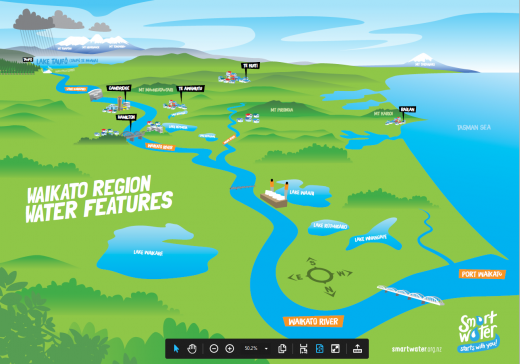
Resources
Waikato Regional Water Features Map
Use this map to get an over view of the Waikato catchment and main water features that provide our Drinking Water Supply.
View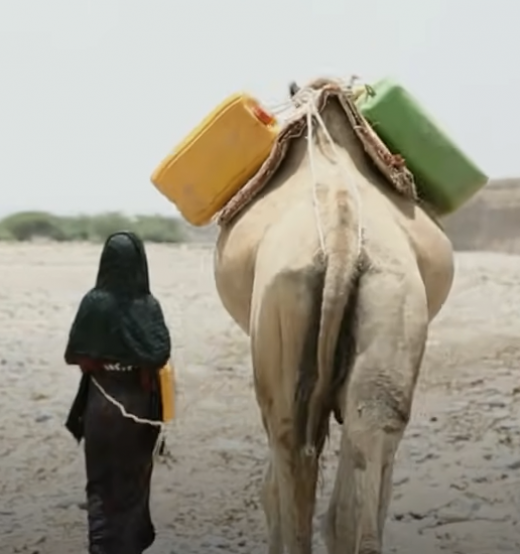
Media
Water doesn't come from a tap - Unicef
A video of 13 year old girl who spends 8 hours a day fetching water in Ethiopia - UNICEF
View
Articles
Managing classroom discussions - SLH
Tips and resources to help with managing a successful class discussion - Science Learning Hub
View
Articles
Alternative Conceptions about Water's states of matter
This resource introduces common student alternative conceptions about changes and states of matter as they relate to water. It is important that teachers are aware of these during a sequence of lessons so students have a chance to begin changes in their thinking as the sequence progresses.
View
Links
Global drought risk and water stress - DG ECHO Daily Map
A webpage of global drought risk and water stress - DG ECHO Daily Map
ViewActivities
Comparing water access and challenges
Word document with cut out statements to compare water access from different countries.
View
Articles
Water catchments
A water catchment is the area of land that catches and channels water until it reaches its' outlet via the lowest point. This can be via groundwater channels, across land, streams, wetlands, rivers or the ocean. Our catchment for our drinking water can be along way from where we source it.
View
Media
Te mana o te wai Introduction and Overview
A video of Freshwater regulations introduced by the NZ Government in 2020 for two sets of values - good governance, stewardship, care and respect for water. Secondly Maori values; Manawhakahaere which is the way Iwi and hapu wish to govern the use of land and water. Ministry for Environment
ViewActivities
Reimagining WASH - Water security for all
A Unicef Pdf exploring water scarcity around the world.
ViewResources
Steps in getting water ready to drink - answers
A table of the answers of the steps in getting water ready to drink
ViewActivities
Thinking about causes and effects of issues
Use this table to fill in the causes and effects for issues you've identified around drinking water.
ViewActivities
Smart Water - Inquiry plan and student reflection
A slideshow of Smart Water inquiry plan and student reflection
ViewArticles
The 'Participating and contributing' strand
This article is about students using their science understanding to participate and contribute to their own lives and to society.
ViewResources
The Water Cycle poster
A poster of water cycle process of evaporation, precipitation and infiltration.
View
Activities
Water flows and catchments SLH
An interactive to discover information and hands-on activities about river catchments. - Science Learning Hub
ViewArticles
A Guide to Hamilton's Water Supply - River to Tap - Waikato Regional Council
Article about Hamilton's water supply and treatment including the 10 lines of defence to provide you with safe quality drinking water.
View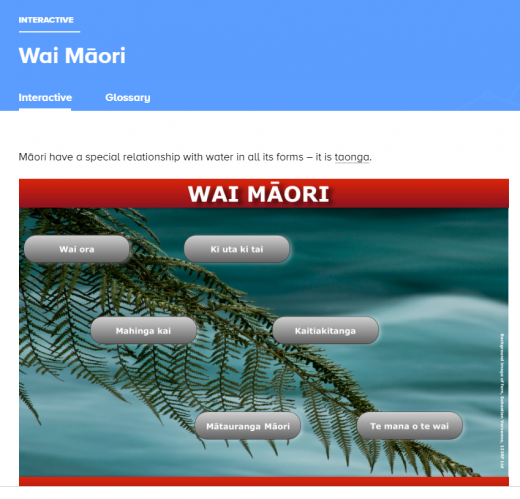
Activities
Wai Māori
Information about the values and connections between Iwi, Wai and Awa and the work of Waikato Māori to look after their taonga.
ViewActivities
Water proportions on Earth
A table of demonstration to show the relative availability of surface water.
View
Resources
Sources of drinking water for Waitomo district
This map show catchments, water sources, water treatment plants and reservoirs around Waitomo. Use this map for completing activities in 'Water in the Waikato' exercise.
View
Articles
States of matter
This Science Learning Hub article explores water in its' various states; liquids, gases, solids.
ViewArticles
Kaitiakitanga and mana whakahaere
An article of the protection and the authority of the Waikato-Tainui based on a traditional Maori world view.
ViewMedia
Regeneration at Port Waikato
A video of a Port Waikato man starting to see an environmental transformation on their block of steep hill country with the help of Waikato River Authority funding
ViewLinks
Whakataukī
An article of the Whakataukī (proverbs and sayings) are important in Waikato-Tainui oral traditions. They often identify important places or symbols.
Activities
Water issues activity
In this activity, students investigate the issues surrounding water in their local area and relate this knowledge to water issues in other countries
View
Resources
Kaitiakitanga
What is Kaitiakitanga? Use this diagram as an example to discuss and explore what Kitiakitanga means to your class.
View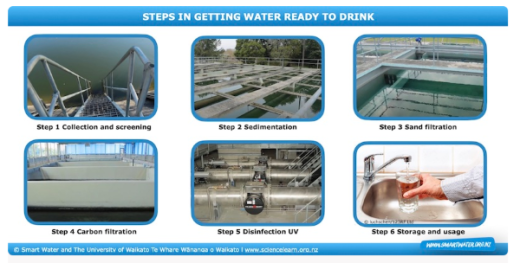
Links
Steps in getting water ready to drink
This interactive uses Hamilton City Council's drinking water treatment plant as an example of the treatment process.
ViewResources
Taking action for conservation
This session supports teachers to help foster students' inquiry skills in a conservation context
View
Media
Smart Water tour of your treatment plant video with Hamilton City Council water sources
A video of the Smart Water tour of your treatment plant with Hamilton City Council water sources.
View
Links
Shorter shower calculator
Take the Smart Water shower and electricity quiz. Find out how much water, power and money you can save!
View
Activities
Examples of the states of water in nature
A word document table for you to print out for students to explore various states of water in their local environment.
ViewArticles
Water quality - factors and issues
An article of the factors affecting water quality, indicators of water quality, identifying pollution sources
ViewLinks
Waitomo District Council - water services
The website of Waitomo District Council Water Supply
View
Links
Water classification map
Waikato Regional Council's water classification interactive map. Explore the local water features of your region.
View
Activities
Learning about the water cycle
An interactive to discover information and hands-on activities about the water cycle.
View
Articles
Reimagining Water WASH: Water Security for all
A pdf of water security and scarcity relative information
ViewActivities
Thinking about causes and effects of issues - example answers
Teacher's Guide - Thinking about causes and effects - possible answers
View
Activities
Our use of water - impacts on water quality
This interactive shows how water and the services that rely on it have an impact on the water quality, and what we can do to lessen the impacts.
View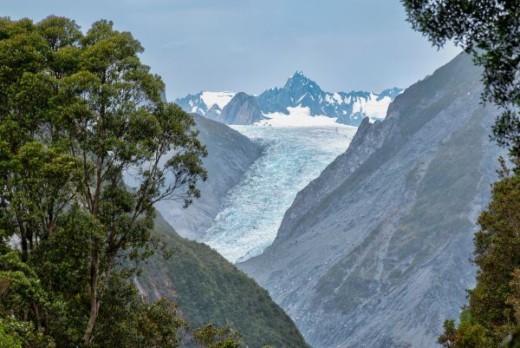
Articles
Disappearing glaciers
New Zealand has over 300 glaciers. However, joining many glaciers around the world our glaciers have been in a state of retreat since 2008. Learn about our glaciers and how important they are in this Science Learning Hub article.
ViewResources
Recording our ideas about freshwater
A table for recording students' ideas about freshwater.
ViewActivities
Student Handout - Steps in getting water ready to drink Drag and Drop
You can either use the online interactive or this print out for the Activity "Getting Water Ready to Drink'
Students cut out and match the steps in the drinking water treatment processes.
Teachers answers are provided.

Activities
Find the Waikato water features
A table for students to write the names and add description of the water features or explain why they are important
View
Resources
Inquiry plan and student reflection
This slideshow is part of a larger inquiry unit about freshwater by Smart Water and the Science Learning Hub. The slideshow relates to all activity topics in the Smart Water Schools Resource. Questions to start your class thinking about water and record their results. Teachers notes within slideshow provide extra discussion points and links to further resources.
ViewActivities
Water proportions on Earth
A table of a demonstration to show the relative availability of surface water
View
Activities
Water views and values: true or false - printable table
A word table of the water views and values - use with the water views and values graphic organiser.
View
Activities
Water views and values: true or false - online
Use this interactive graphic organiser to explore views and values about water. Science Learning Hub.
ViewArticles
Waikato Regional Council : How clean is the Waikato River
An article of the quality of the waikato river
View
Activities
Climate change challenging conversations
An activity designed for use within the classroom and to support student discussions about climate change.
View
Activities
Being smart with water
An activity for students to use knowledge, skills and research and information from their inquiries to make a difference and learn how to be smart with water use.
ViewActivities
Water sources in Waikato examples
A table to use for finding an example of water sources
ViewArticles
Global action
An article explains science ideas associated with climate change, also delves into NZ greenhouse gas emissions and ways in which local scientists are working to reduce them
ViewActivities
Water pollutants on trial activity
In this activity, students research the effect of common pollutions on our waterways and hold a mock trial to determine the worst pollutant in the country.
View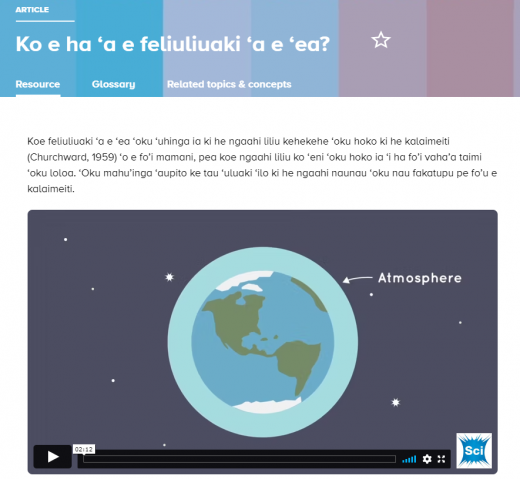
Articles
Ko e ha ‘a e feliuliuaki ‘a e ‘ea?
This article on climate change is in Faka-Tongan. It contains links to other articles, videos and activities about climate change.
View
Links
Smart Water Alert Levels
During summer, councils may need to restrict water use to ensure there is enough for everyone
View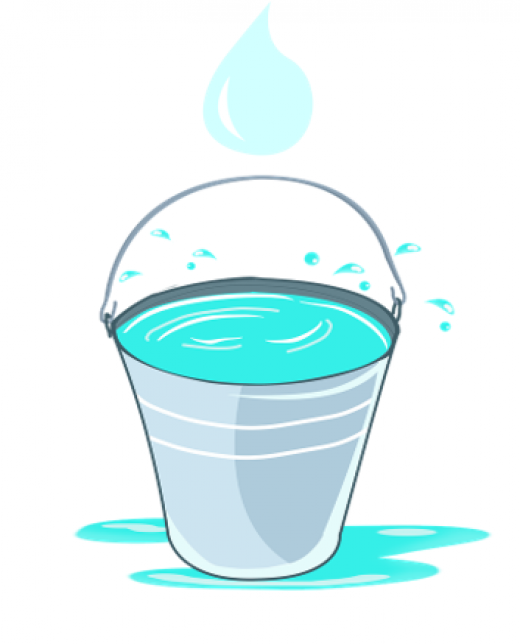
Activities
'A Drop in the Bucket' Power Point Activity
Follow this Power Point activity as a class lesson to discover just how much freshwater exists on Earth.
You will need:
A Bucket full of water
A Cup
A spoon and some salt

